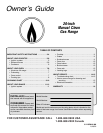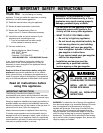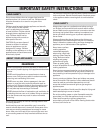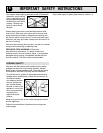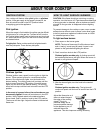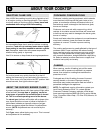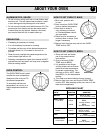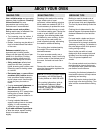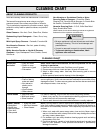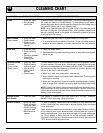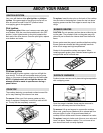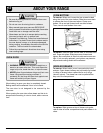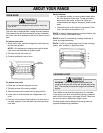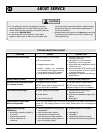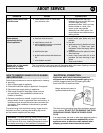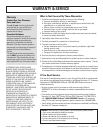
ABOUT YOUR OVEN
8
BAKING TIPS
Useareliablerecipeand accurately
measure fresh ingredients. Carefully
follow directions for oven
temperature and cooking time.
Preheat oven if recommended.
Use the correct rack position.
Baking results may be affected if the
wrong rack position is used.
S Top browning may be darker if
food is located toward the top of
the oven.
S Bottom browning may be darker if
food is located toward the bottom
of the oven.
Bakeware material play s an
important part in baking results.
Always use the type and size of pan
called for in the recipe. Cooking
times or cooking results may be
affected if the wrong size is used.
S Shiny metal pan reflects heat
away from the food, produces
lighter browning and a softer crust.
Use shiny pans for baking cakes
or cookies.
S Dark metal pan or a pan with an
anodized (dull) bottom absorbs
heat, produces darker browning
and a c risper crust. Use this type
of pan for pies, pie crusts or
bread.
S If using oven-proof glassware,or
dark pans such as Baker’s
Secret reduce the oven
temperature by 25°F except when
baking pies or bread. Use the
same baking time as called for in
the recipe.
S If using insulated bakeware,
expect cooking times to increase
slightly. It is not necessary to
adjust the oven temperature.
If you add additional ingredients
or alter the recipe, expect cooking
times to increase or decrease
slightly.
ROASTING TIPS
Roasting is the method for cooking
large, tender cuts of meat
uncovered, without adding moisture.
Most meats are roasted at 325°F. I t
is not necessary to preheat the oven.
Place the meat fat-side-up on a rack
in a shallow roasting pan. Placing the
meat on a rack holds it out of the
drippings, thus allowing better heat
circulation for even cooking. As the
fat on top of the roast melts, the
meat is basted naturally, eliminating
the need for additional bas ting.
The cooking time is determined by
the w eight of the meat and the
desired doneness.
For more accurate results, use a
meat thermometer. Insert it so the tip
is in the center of the thickest part of
the meat. It should not touch fat or
bone.
Remove the roast from the oven
when the thermometer registers the
desired doneness.
NOTE: For more information about
food safety, call USDA’ s Meat &
Poultry Hotline at 1-800-535-4555.
For cooking information, write to
the National Cattlemen’s Beef
Association, 444 North Michigan
Avenue, Chicago, Illinois 60611, or
call 1-800-368-3138.
BROILING TIPS
Broiling is used for tender cuts of
meat or marinated meats, poultry,
fish and some fruits and vegetables.
The food is placed directly under the
burner .
Cooking time is determined by the
desired degree of doneness and the
distance between the food and the
burner .
For best results, steaks and chops
should be at least 3/4-inch thick.
Trim excess f at to prevent excessive
spattering or smoking. Cut slashes in
the outer edges of the fat to prevent
curling during cooking.
Use a broiler pan with an insert
designed to dr ain excess liquid and
fat away from the cooking surface.
This is to prevent spatters and
smoke.
For a brown exterior and rare interior,
meat should be close to the burner .
For well-done meat, place the broiler
pan farther from the burner.
Increasing the distance between the
meat and the burner will help reduce
spattering and smoking.
Foods that require turning should be
turned only once during broiling. Turn
after half the recommended cooking
time.



